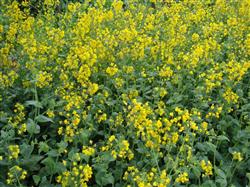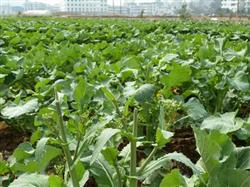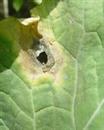Symptomatic control of rape stiff seedlings

In the early stage of field growth after transplanting slow seedlings, rigid seedlings sometimes appeared, such as reddish leaves and yellow leaves, leaf center curls, slow growth or cessation of growth, poor growth and so on. Targeted measures should be taken to prevent and control rape stiff seedlings on the basis of investigating the causes of stiff seedlings. The drought of stiff seedlings caused by drought or waterlogging injury not only causes the lack of water, but also accompanied by the symptoms of element deficiency, such as red and purple leaves. According to the field investigation, the surface layer of soil is white and hardened, even cracked, and the plant may wilt at noon on a sunny day; it may also cause anoxic and rigid rape seedlings due to poor drainage of transplanting field or continuous overcast and rainy weather after transplanting. For dry and stiff seedlings, no-tillage transplanting can be used, irrigation to the ditch depth of 2pg 3, let water infiltrate into the soil; ploughing and transplanting fields can be irrigated (drenched) to resist drought, combined with topdressing, that is, thin fertilizer liquid should be applied; for stiff seedlings caused by waterlogging, it is necessary to dredge or deepen the drainage ditch and lower the groundwater level. And combine with ploughing, apply plant ash or rotten stable (pile) fertilizer to raise the soil temperature. The stiff seedlings caused by lack of fertilizer are short and short, the leaves are narrow and yellow-green, and the leaves at the base of the stem turn red in serious cases, indicating that the plants are deficient in nitrogen, so it is necessary to apply available nitrogen fertilizer in time, and apply 15kg ammonium bicarbonate per mu to thin manure; if the upper leaves are dark green, the lower leaves are purplish red, the leaves emerge slowly, and the root system is poorly developed, it is a symptom of phosphorus deficiency. This can be foliar sprayed with 0.3% potassium dihydrogen phosphate solution 2 times 3 times, once every 3-5 days. At the same time, 25 kg of calcium superphosphate or 30kg of calcium magnesium phosphate fertilizer were applied per mu. The phosphate fertilizer can be mixed with organic fertilizer before composting fermentation and after ripening, and the stiff seedlings caused by boron deficiency may be characterized by slow plant growth, serious rotting roots, withered heart and purple leaves. In this regard, 0.1% borax solution can be sprayed on the leaves of 30kg / mu, or 0.5kg / mu of borax can be applied to 100kg / 150kg of water. Stiff seedlings caused by diseases and insect pests are often caused by aphids, which cause plant atrophy and virus disease. In this regard, it is necessary to strictly guard against the harm of aphids. When local aphids are found, 100% aphid lice Jing (imidacloprid, Yuanjing, Kangfuduo, Dachongchen) can be sprayed with 2500 to 3000 times. If symptoms of virus disease are found, spray 2 times with 5% chlorpromazine 300 times 400 times in time, once every 7 days. At the same time, pay attention to the use of 2.5% of the enemy to kill and control cabbage insects. Due to the hardening of the rigid seedlings caused by soil consolidation, the root system of the plant is underdeveloped. To do a good job in mid-ploughing, we should do a good job of shallow hoeing and loosening the topsoil for the first time, shallow hoeing and scraping the grass at the edge of the plant, deep hoeing and loosening soil between rows, and removing weeds.
- Prev

How to prevent rape Fertilizer damage
1. To reform the fertilization method in accordance with the principle of practicality, practicality and effectiveness, the compost and mature organic fertilizer made by retting with enzyme bacteria are recommended, and the method of layered application or deep application of the whole layer is adopted. According to the planned stubble and the total amount of fertilizer in the current year, it can be applied at one time during deep ploughing, and the formula fertilization technology can be adopted to master the three elements of nitrogen, phosphorus and potassium.
- Next

Opinions on the occurrence and control of Sclerotinia sclerotiorum in rape
The growth period of rape this year is earlier than that of last year, and its growth is close to that of last year. The incidence characteristics of Sclerotinia sclerotiorum in rape this year are different from those in previous years. According to the comprehensive analysis of many factors, such as the source of bacteria in the field, the growth of rape, the disease resistance of varieties and the climatic conditions of susceptible growth period, the degree of natural occurrence is moderately prevalent. ...
Related
- The first cup of black tea in spring, the flavor and history of tea gardens in Kenya, Africa
- The computer can not only choose potatoes, but also grow tea rice. AI will grow winter oolong tea champion.
- It is not only the inflated tea bitten by insects, but also engraved with the four seasons tea in Beipu.
- The Oriental Beauty Tea Festival in Zhuxian County takes the stage at the weekend to experience the plus-size feast of oil tea.
- & quot; Oriental Beauty Tea & Exploration of Emei in Hsinchu, the hometown of quot;
- The new variety of strawberry "Tainong 1" dessert is the first choice with mellow aroma. Crimson gorgeous
- History of Tea in Taiwan: from Wild Inner Mountain to Export Tea Garden
- Two types of Taiwan Oriental Beauty Black Tea won the British three-Star Award for Childhood Tea Xiang Zhang Jiaqi changed from pilot to champion tea maker.
- Banana species and varieties: the planting history of Taiwan Xianren banana and dwarf banana is long, is banana disease resistant?
- Coffee planting Technology: Qianjie Coffee from Seedling to harvesting

